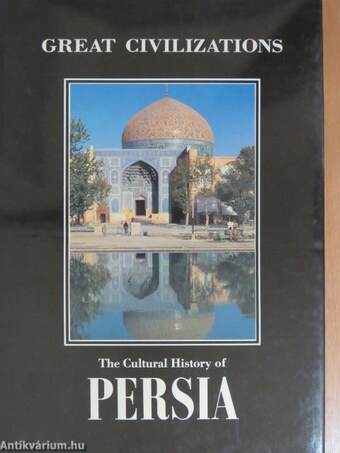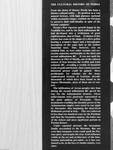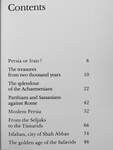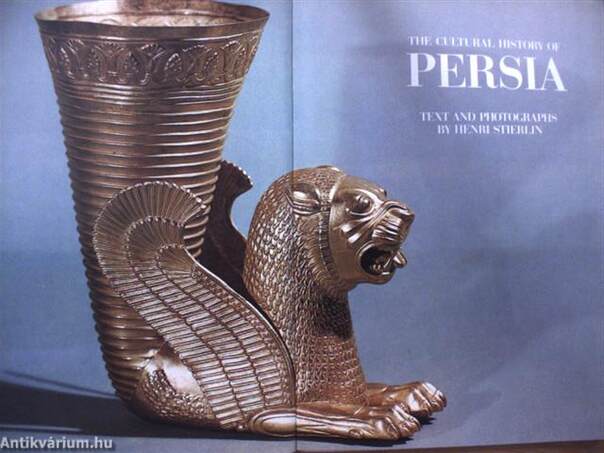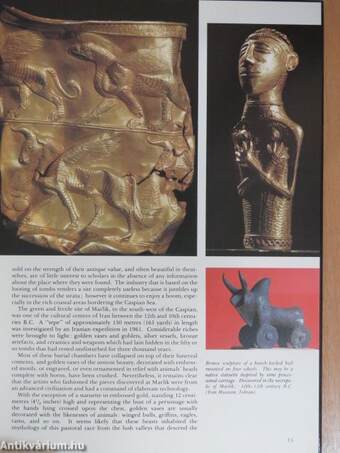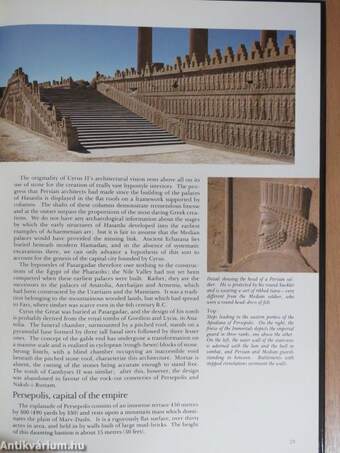1.067.327
kiadvánnyal nyújtjuk Magyarország legnagyobb antikvár könyv-kínálatát

VISSZA
A TETEJÉRE
JAVASLATOKÉszre-
vételek
The Cultural History of Persia
| Kiadó: | Aurum Press Ltd. |
|---|---|
| Kiadás helye: | London |
| Kiadás éve: | |
| Kötés típusa: | Fűzött kemény papírkötés |
| Oldalszám: | 95 oldal |
| Sorozatcím: | Great Civilizations |
| Kötetszám: | |
| Nyelv: | Angol |
| Méret: | 33 cm x 24 cm |
| ISBN: | 0-906053-70-6 |
| Megjegyzés: | Színes fotókkal. |
naponta értesítjük a beérkező friss
kiadványokról
naponta értesítjük a beérkező friss
kiadványokról
Fülszöveg
THE CULTURAL HISTORY OF PERSIA From the dawn of history Persia has been a distinct cultural entity. Its position as a vast natural fortress, with high plateaux enclosed within mountain ranges, enabled the Persians to preserve their individuality in spite of the Islamic conquest. Persia's first vigorous growth began in the Noelithic era, and by the third millennium BC had developed into a civilization of great sophistication, that of Elam. Evidence of this culture has come in the shape of a silver goblet bearing a woman's figure and a hieroglyphic inscription of the same date as the earliest Sumerian texts. This, however, was an isolated find, as were other ceramic and terracotta statuettes attributable to the third and second millenniums BC. It was not until the discovery in 1961 of Marlik, one of the cultural centres of Iran between the twelfth and tenth centuries BC, revealing a wealth of beautiful works in gold and bronzé, that a more accurate historical picture could be gained.... TovábbFülszöveg
THE CULTURAL HISTORY OF PERSIA From the dawn of history Persia has been a distinct cultural entity. Its position as a vast natural fortress, with high plateaux enclosed within mountain ranges, enabled the Persians to preserve their individuality in spite of the Islamic conquest. Persia's first vigorous growth began in the Noelithic era, and by the third millennium BC had developed into a civilization of great sophistication, that of Elam. Evidence of this culture has come in the shape of a silver goblet bearing a woman's figure and a hieroglyphic inscription of the same date as the earliest Sumerian texts. This, however, was an isolated find, as were other ceramic and terracotta statuettes attributable to the third and second millenniums BC. It was not until the discovery in 1961 of Marlik, one of the cultural centres of Iran between the twelfth and tenth centuries BC, revealing a wealth of beautiful works in gold and bronzé, that a more accurate historical picture could be gained. More problematic for scholars are the many sophisticated bronzes of Luristan, literally thousands of which have been found in the Zagros Mountains, most of them out of context. The infiltration of Aryan peoples into Iran during the second millennium BC paved the way for the Achaemenian dynasty, whose achievements were gloriously represented in the great palaces of Persepolis. These monuments extolling the absolute power of the Achaemenian empire were razed in one night by Alexander, thus beginning the short-lived Hellenistic period in Iran. This was followed in less than two hundred years by the Parthian and then the Sassanian empires, the latter one of the richest and most significant periods in Persian history. Under repeated pressure the Sassanians finally succumbed to the Moslems. But not even that traumatic event could quell the Persian spirit, and despite the stray Arab influence visible in the art and architecture of the time, Iranian nationalism prevailed-as it has continued to do, in the face of similar attacks, ever since. VisszaTémakörök
- Idegennyelv > Idegennyelvű könyvek > Angol > Művészetek > Művészettörténet, általános
- Idegennyelv > Idegennyelvű könyvek > Angol > Művelődéstörténet
- Művelődéstörténet > Kultúra > Története
- Művelődéstörténet > Átfogó művek, tanulmányok
- Művészetek > Művészettörténet általános > Kontinensek művészete > Ázsia > Egyéb
- Művészetek > Művészettörténet általános > Idegen nyelv > Angol
- Művészetek > Művészettörténet általános > Művészettörténet > Külföldi
Henri Stierlin
Henri Stierlin műveinek az Antikvarium.hu-n kapható vagy előjegyezhető listáját itt tekintheti meg: Henri Stierlin könyvek, művekMegvásárolható példányok
Nincs megvásárolható példány
A könyv összes megrendelhető példánya elfogyott. Ha kívánja, előjegyezheti a könyvet, és amint a könyv egy újabb példánya elérhető lesz, értesítjük.



